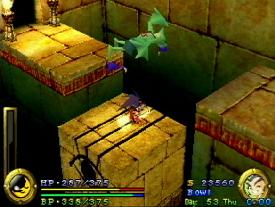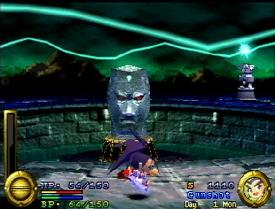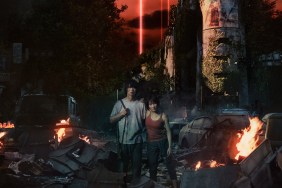BFM? Not much of a BFD.
Brave Fencer Musashi is one of those games that gives me mixed feelings. There’s a lot of
creative gameplay elements that are refreshing to see, but the story and characters are so
silly and nonsensical it ends up rubbing me the wrong way and detracts from the whole
gaming experience.
Coming off a Tenchu-intensive
weekend session, I sat down with a copy of BFM. This is much akin to
going from an Agatha Christie mystery to something from the Hardy Boys. The
story starts out with Princess Fillet (who talks like your worst Valley Girl
nightmare) of the Allucaneet Empire summoning a hero to help in their battle
with the Thirstquencher Empire. And the hero she manages to summon is none other
than Brave Fencer Musashi, who also happens to be a smart-mouthed punk kid.
Then the princess is kidnapped (gee, what a surprise!) and Musashi begins his
journey to find five sacred scrolls that will help him free the princess. Along
the way, Musashi also needs to rescue kidnapped citizens trapped in green gems.
Some are required to complete a quest and some will teach you special sword
techinques or give you hints.
BFM combines elements
of an RPG and a platformer quite seamlessly and it’s fun to play and easy to
get into. Events center around Grillin’ Village and surrounding areas in the
Allucaneet empire. Although the game takes place in a strict linear fashion,
there are loads of sub-quests Musashi is required to do as well. When you’re
in the village, you play RPG- style; buying and selling items, talking to villagers,
etc. When you venture out on a quest, it’s platform all the way; lots of jumping
onto moving platforms and figuring your way through puzzles. The best part about
this format is that Square abandoned the random battle idea altogether. Although
it makes the game a little easier, it also makes it much less tedious and aggravating.
The best part of BFM is the game’s concept of time. There’s a clock
on the screen that tells you not only the time of day, but also the day of the
week, and you can only visit shops during their normal business hours. You can
also tell the passage of time by the amount daylight, which looks very cool
and includes crickets chirping at night and birds singing at the crack of dawn.
Perishable foods (like milk) will spoil after a certain length of time while
others (like cheese) get better with age. You’ll also notice that all the characters
act differently according to the time, meaning some you can only meet during
day and others only at night. There are plenty of places in the game that rely
on the passage of time, such as an island that’s only accessible at low tide.
Musashi also gets tired, so you’ll have to sleep to rejuvenate yourself and
make sure you’re fully rested before you go into that long boss fight. The concept
of time in BFM isn’t just an eye-pleasing gimmick – it’s incorporated
into the gameplay beautifully and unlike anything I’ve played.
Another innovative aspect of the game is Musashi’s assimilation skills. Much
like the “Enemy Skill” in Final
Fantasy 7, Musashi can learn his enemy’s special moves. However, these aren’t
just used for combat purposes. Some puzzles require you to learn a skill in
order to traverse a particularly difficult or stubborn obstacle. So if you get
stuck somewhere, go assimilate an enemy move and it may get you out of the jam.

The characters in BFM leave much to be desired. Even Musashi isn’t all that likable of a
character, since he talks and acts like an annoying kid. His supposed “witty” commentary
is only funny to the 10-and-under crowd and just plain stupid to everyone else. All the
female characters, like, talk like Valley Girls, like y’know? Like totally. And they all act like
your annoying little sister; even the Princess, which really didn’t make me want to save her
the least bit. That little teeny-bopper can rot in the dungeon for all I care…(How noble of you – Ed.)
Musashi does have his rare moments as a ‘Dirk the Daring’ type of hero. He’s a
bumbling idiot who accomplishes difficult tasks not because of any particular
intelligence or skill on his part, but because of luck. A million laughs.
A rather unique (albeit puzzling) feature of the game is the toy store. Here,
you can buy action figures of the characters and monsters you encounter in the
game. I have no idea what purpose this serves, but you can purchase a figure,
take it back to your room and examine the blister pack from every angle. Then
you have the option to “open” it and “play” with it. Each figure has signature
moves that it can do and if you’re real lucky maybe you can find that rare Musashi
figure with the Kung-Fu Grip.
The background graphics look good, but nothing especially spectacular. Characters
and enemies are your garden-variety polygonal figures with no additional textures.
Some nice touches include smoke effects that emanate from the source and little
clouds of breath that come from Musashi’s mouth in cold weather. There’s hardly
any noticeable pop-up, which is worthy of note.
Music and sound are top-notch, from the catchy tunes to the clashing of swords and the ice-
scraping sounds coming from penguins bum-rushing you. One interesting note: every palace
musician you rescue will change the palace’s theme music. For example, after the flutist is
rescued, that instrument will be included the next time you visit the palace. Pretty cool.
Brave Fencer Musashi has some cool gameplay elements in it that will
wow the most jaded console gamer, but the formulaic story, annoying characters,
and “kiddie” feel of the game end up distracting the gamer as well as knocking
it down a grade.
-
Passage of time is awesome!
-
No random battles!
-
Successfully combines platform and RPG genres.
-
Solid gameplay.
-
Annoying characters/contrived plot
-
Game has too much of a kiddie feel.











